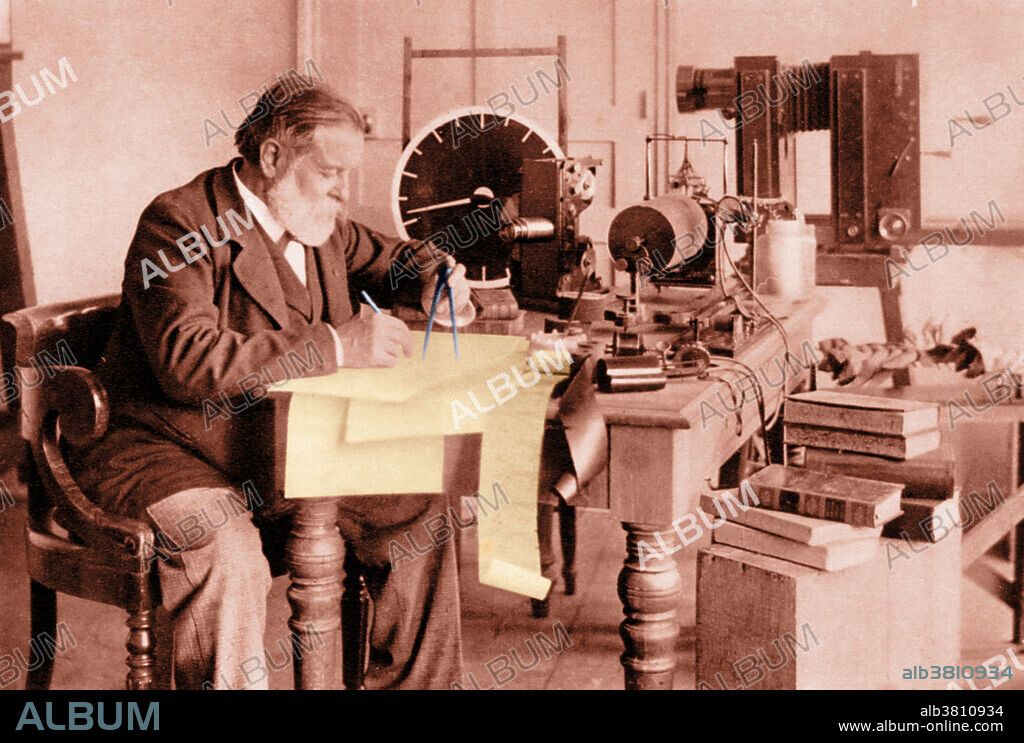alb3810934
Etienne-Jules Marey, French Chronophotographer

|
Ajouter à une autre Lightbox |
|
Ajouter à une autre Lightbox |



Avez-vous déjà un compte? S'identifier
Vous n'avez pas de compte ? S'inscrire
Acheter cette image
Titre:
Etienne-Jules Marey, French Chronophotographer
Légende:
Voir la traduction automatique
Marey among his inventions (sphygmograph, sound-recording instruments, model of bird-flight, projector, camera). Etienne-Jules Marey (March 5, 1830 - May 21, 1904) was a French scientist, physiologist and chronophotographer. He started by studying blood circulation in the human body. Then shifted to analyzing heart beats, respiration, muscles (myography), and movement of the body. He became fascinated by movements of air and started to study birds. He adopted and further developed animated photography into a separate field of chronophotography in the 1880s. His revolutionary idea was to record several phases of movement on one photographic surface. In 1882 he made his chronophotographic gun. This instrument was capable of taking 12 consecutive frames a second, and the most interesting fact is that all the frames were recorded on the same picture. Using these pictures he studied mammals, birds, fish, microscopic creatures, mollusks, insects and reptiles. His research on how to capture and display moving images helped the emerging field of cinematography. His last great work was the observation and photography of smoke trails. In 1901 he was able to build a smoke machine with 58 smoke trails. It became one of the first aerodynamic wind tunnels. He died at the age of 74.
Crédit:
Album / Science Source / change accordingly
Autorisations:
Modèle: Non - Propriété: Non
Questions sur les droits?
Questions sur les droits?
Taille de l'image:
3750 x 2526 px | 27.1 MB
Taille d'impression:
31.8 x 21.4 cm | 12.5 x 8.4 in (300 dpi)
Mots clés:
ART, PHOTOGRAPHIE • CAMERA • CÉLÈBRE • CELEBRITE • CHRONOPHOTOGRAPHIE • CIRCULATION • COEUR • COEURS • CORPS COEUR • EMBOUTEILLAGE • EUROPÉEN • HOMME DE SCIENCE • HOMME • INSTANTANE (PHOTO) • INSTANTANÉ • MAREY • MOUVEMENT • PERSONNAGES • PERSONNALITÉS • PERSONNE • PHOTOGRAPHIE • PHYSIOLOGIE • PORTAIT • PORTRAIT • POTRAIT • RESPIRATION • SANG • SANGUIN • SAVANT • SCIENTIFIQUE • SNAPSHOT • TRAFFIC • TRAFIC • XIXE SIÈCLE • XXE SIECLE
 Pinterest
Pinterest Twitter
Twitter Facebook
Facebook Copier le lien
Copier le lien Email
Email
